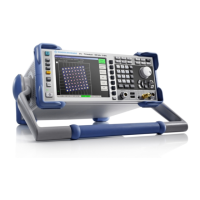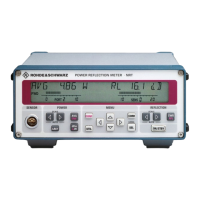R&S FSH Power measurements on TDMA signals
1309.6275.12 4.41 E-2
Optimizing the reference level
T
o obtain the greatest possible dynamic range for burst signals, the lowest reference level possible
must be set. If this is not done, the R&S FSH will be overdriven by the measurement signal, if its
maximum level exceeds the maximum reference level. Because the R&S FSH’s resolution bandwidths
are implemented digitally after the A/D converter, depending on the resolution bandwidth selected, the
signal level at the A/D converter can be higher than the level indicated by the trace. To prevent the A/D
converter from being overdriven, the signal must be measured at the widest resolution bandwidth
(3 MHz) and video bandwidth (3 MHz) with the peak detector. The trace maximum then determines the
optimal reference level.
The R&S FSH’s LEVEL ADJUST routine will automatically determine the optimal reference level for
you.
Press the LEVEL ADJUST softkey.
The R&S FSH starts the measurement to determine
the optimal reference level, using a resolution
bandwidth of 3 MHz, a video bandwidth of 3 MHz and
the peak detector. While the measurement is in
progress, the R&S FSH outputs the message
“Adjusting level for measurement, please wait... ".
The optimal reference level is then set.
Power readout
The R&S FSH displays the measured power and the selected burst length above the measurement
diagram (Power = nn.nn dBm).
Setting the trigger
A trigger is usually required to perform power measurements on bursts. In the default setting, the
R&S FSH is configured to use the video trigger at 50 % of the Y scale on the measurement diagram.
Assuming that the burst on which the measurement is to be made crosses the 50 % point of the trigger,
the R&S FSH will trigger on the rising edge of the burst.
Should this not be the case, the trigger level must be adjusted so that the R&S FSH is triggered by the
burst edge. Otherwise no measurement will be performed.
If the DUT has a trigger facility, the external trigger can also be used for the measurement.
Connect the DUT’s trigger output to the
R&S FSH’s trigger input.
Press the SWEEP key.
Press the TRIGGER softkey.
Select the EXTERNAL RISE or EXTERNAL FALL
menu item (rising or falling edge).
Confirm your selection with the ENTER key or the
TRIGGER softkey.
Select the appropriate trigger delay to position the
burst in the measurement window.
Press the TRIGGER softkey.

